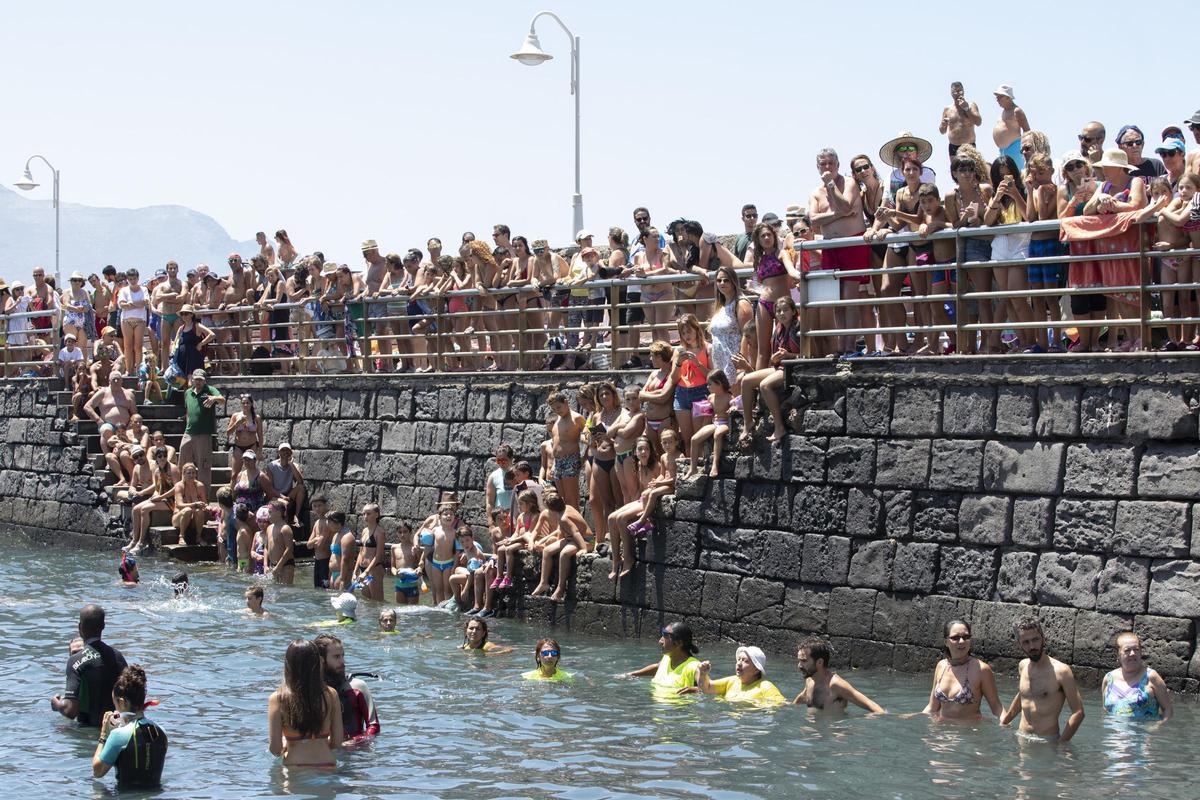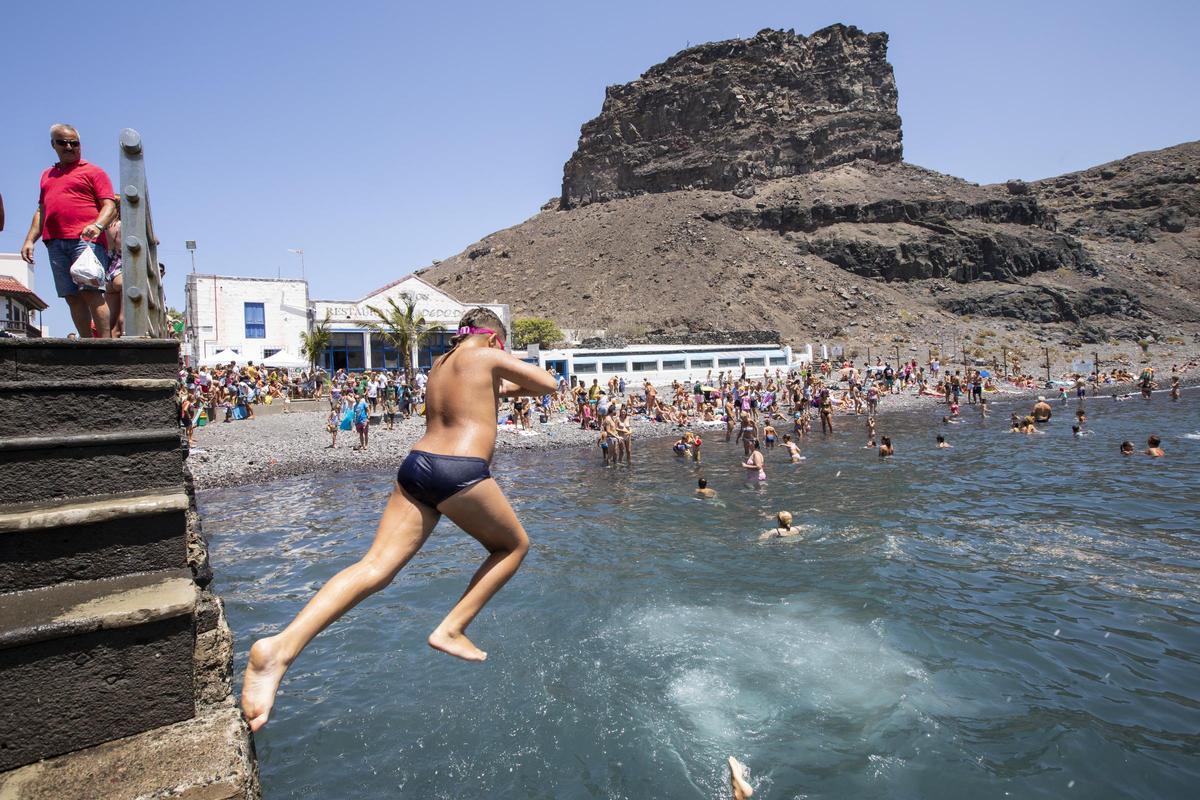Agaete City Council has requested the transfer of the century-old Old Pier, located next to the Finger of God in Las Nieves, from Puertos Canarios, which is a symbol for residents and visitors alike. The pier is currently in a state of limbo in terms of management competencies, despite having been proposed as a Cultural Interest Site (BIC) in the past. The municipal government aims to regularise activities in the area, such as terraces and service provision, as well as revitalise the cove, including the possibility of resurrecting an old project to install a small pontoon to facilitate nautical activities.
The City Council is responsible for cleaning the area, ensuring bathers’ safety, and carrying out maintenance tasks, including rehabilitating the solarium. However, in practice, it falls outside its jurisdiction, and each time an activity needs to be carried out, it must refer to the Canary Islands Autonomous Community, which oversees the entire Agaete port, the most profitable in Gran Canaria thanks to maritime traffic with Tenerife.
Mayor Jesús González acknowledges that the Old Pier is caught between administrations, a situation he aims to resolve through the transfer. The request has already been discussed in the latest regional port authority board meeting, and they are now reviewing the details of the process. “We need to find a solution,” he adds, noting that boundaries and technical details need to be established, taking into account port activities.
From fruits to blockbuster movies
[–>
González points out that the current situation could lead to issues in the event of an accident. He also stresses the necessity of this step to organize the terrace situation, ensuring they comply with municipal regulations.
The mayor highlights that this area is a symbol for Agaete, not only due to the history of the pier but also because of its iconic view with the Finger of God, the Tamadaba cliffs, and the coast with La Aldea. Additionally, he mentions that even for filming movies, the legal framework of the old pier, which served as a communication bridge for the transportation of fruits and vegetables with Tenerife and Europe, needs to be clarified.

The breakwater, seen from the water. / LP / DLP
The mayor clarifies that the transfer would pave the way for greater visibility of the pier. He recalls that a strategic plan was once designed to promote nautical activities, including proposals such as installing a pontoon for assisting kayaks and small boats. In this regard, González questions why Agaete lacks nautical companies in its waters, despite facing the sea.
The City Council unanimously approved an initiative on November 20, 2018, across all political groups to process the declaration of Agaete’s Old Pier as a Cultural Interest Site (BIC). However, the proposal did not progress further and remains shelved.
The BIC’s influential area, as stated, was set to encompass from the old dock to the rear of the outer port’s breakwater, spanning a radius of about 500 meters, based on the government’s environmental study for the port on coastal dynamics.
Natural Cove of the Conquest
[–>
The port infrastructure, awarded construction in 1875, is included in the Agaete Architectural Catalogue with full protection. It is publicly owned and only allows for “conservation, restoration and rehabilitation as types of interventions,” according to the mentioned dossier.

A teenager jumping into the water. / LP / DLP
In the area, remains of shipwrecks, ceramic fragments, and ancient anchors have been discovered at depths of up to 40 meters. Therefore, if a submarine exploration is conducted, more historically significant remnants may surface, as the area has served as an anchorage for ships for centuries.
The fortress tower
[–>
The municipal proposal considered the historical data that in 1481 the Puerto de Las Nieves began its history as a natural cove of the Conquest of the northern part of the Island, linked to the construction process of the fortress tower of Agaete. With the subsequent sugar trade, it became a port connecting with markets in northern Europe, especially with the Netherlands, as well as a anchorage for ships trading with Tenerife.
The Ministry of Public Works approved on November 9, 1864, the construction of the Las Nieves dock, designed by the engineer Juan de León y Castillo.
[–>
The work was put up for auction in 1875 for 105,000 pesetas, being awarded to the local contractor Antonio de Armas.
The crane and the stones from the Roque
The work was approved on November 9, 1864, but it was not until a decade later that the Ministry of Public Works gave the green light for its construction. León y Castillo’s original idea was to create a 260-meter-long infrastructure, made of masonry, with lime and sand mortar and stone finishes, using stones from Roque de las Nieves and quarries in Arucas, according to the Heritage Site of the Island Council. The works were completed in 1903, as we know it today, but only with 130 meters. One of the most symbolic elements is the old crane, which many children used as a water launcher. It was installed in the first half of the 20th century for the handling of agricultural products from El Valle. It is a piece with an iron arm, anchored to the ground.
Subscribe to continue reading
















